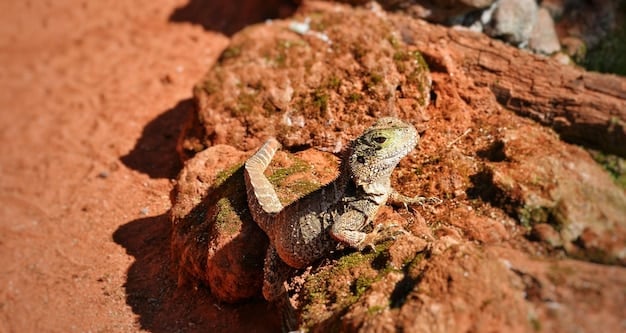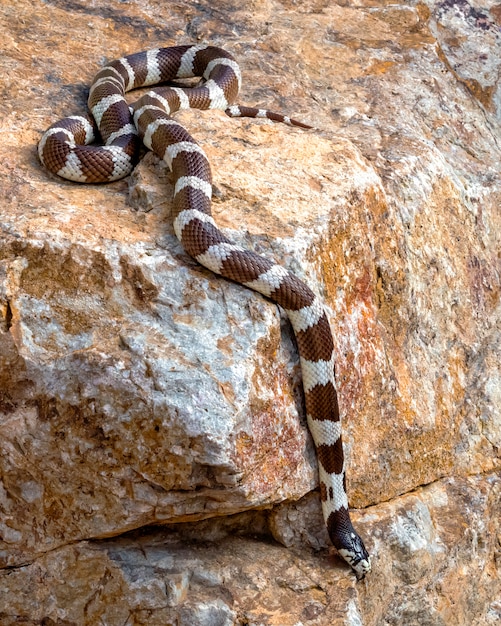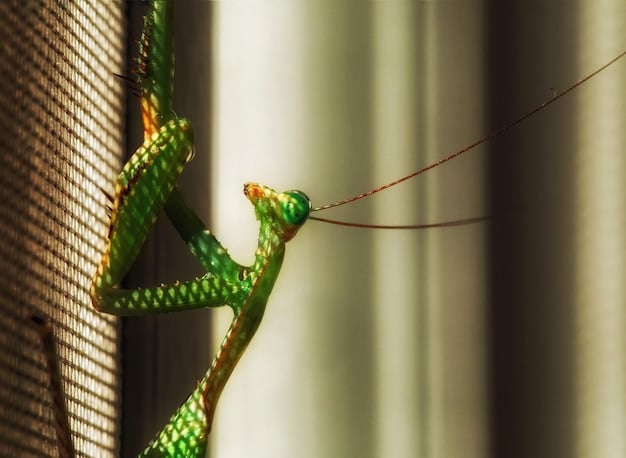Reptilian Thermoregulation: Understanding How Temperature Influences Behavior

Understanding reptilian thermoregulation involves studying how reptiles maintain their body temperature through behavioral and physiological mechanisms, since external temperatures greatly influence their activity levels, metabolic rates, and overall survival.
Reptiles, being ectothermic creatures, rely heavily on external sources of heat to regulate their body temperature. Understanding reptilian thermoregulation: how temperature influences behavior is crucial for comprehending their survival strategies and ecological roles.
Understanding Reptilian Thermoregulation: An Overview
Reptilian thermoregulation is a fascinating adaptation that allows these animals to thrive in diverse environments. It’s a complex interplay of behavior and physiology, dictated by the surrounding temperature. Let’s delve into the basics of how reptiles manage their internal heat.
Ectothermy Explained
Unlike mammals and birds, reptiles don’t generate significant internal heat. This means they depend on external heat sources to function optimally.
Behavioral Thermoregulation
Reptiles use a variety of behaviors to control their body temperature, from basking in the sun to seeking shade.
- Basking: Absorbing solar radiation to raise body temperature.
- Shuttling: Moving between sunny and shady spots to maintain a preferred temperature.
- Burrowing: Seeking refuge underground to avoid extreme temperatures.
Understanding these behaviors is key to appreciating how reptiles survive in their respective habitats. They are masters of adapting to their thermal environment.

Thermoregulation isn’t just about staying warm; it’s about maintaining a specific body temperature range that allows reptiles to perform essential functions. This includes digestion, movement, and reproduction. If a reptile’s body temperature deviates too much from this range, it can have serious consequences for its health and survival. Reptiles use a combination of behavioral and physiological adaptations to precisely control their body temperature, even in fluctuating environments.
The Role of Physiology in Thermoregulation
While behavior is vital, physiological mechanisms also play a role in reptilian thermoregulation. These responses help reptiles fine-tune their body temperature.
Circulatory Adjustments
Reptiles can alter blood flow to the skin to either conserve or dissipate heat.
Color Change
Some reptiles can change the color of their skin to absorb more or less solar radiation.
- Darkening: Increasing absorption of heat.
- Lightening: Reducing absorption of heat.
- Vasodilation: Dilation of blood vessels, increasing heat loss.
Physiological adaptations combined with behavioral strategies constitute reptile thermoregulation. These features are important for survival in varied environmental conditions.
These adaptations are incredibly useful, but they also have limitations. For example, a reptile that relies on basking to warm up may be vulnerable to predators while it’s exposed. Similarly, a reptile that seeks shade to cool down may have difficulty finding food or mates if it spends too much time hidden. Therefore, reptiles must constantly balance the need to thermoregulate with other demands on their time and energy.
Environmental Factors Affecting Thermoregulation
The environment plays a crucial role in shaping reptilian thermoregulation. Factors like temperature, humidity, and sunlight availability all influence reptile behavior.
Temperature Gradients
Reptiles exploit temperature gradients within their environment to regulate their body temperature.
Habitat Selection
Reptiles choose habitats that offer suitable thermal conditions.
- Deserts: High solar radiation and extreme temperatures.
- Forests: Shaded areas and cooler temperatures.
- Aquatic environments: Maintain stable water temperatures.
The environment shapes these reptiles’ thermoregulation strategies. As a result, reptiles may display variations in appearance and behavior.
For instance, a desert lizard might have a pale coloration to reflect sunlight and avoid overheating, while a forest-dwelling snake might have a dark coloration to absorb more heat in the shaded environment. These adaptations are not just physical; they also influence reptile behavior. For example, a desert lizard might be most active during the early morning and late afternoon when temperatures are milder, while a forest snake might be active throughout the day, taking advantage of the relatively constant temperature under the forest canopy.

Thermoregulation and Reptilian Behavior
The link between thermoregulation and behavior is inextricably linked. Reptiles modify their behavior drastically to keep their body temperature stable.
Activity Patterns
Daily and seasonal rhythms of activity are often dictated by temperature.
Feeding Habits
Temperature affects digestion rates and, consequently, feeding behavior.
- Diurnal Activity: Being active during the day.
- Nocturnal Activity: Being active during the night.
- Crepuscular Activity: Being active during dawn and dusk.
Understanding reptilian behavior and thermoregulation go hand-in-hand. Patterns of activity are influenced by the surrounding temperatures.
In addition to influencing activity patterns and feeding habits, temperature also affects reproduction in reptiles. For example, in some species, the temperature of the nest determines the sex of the offspring. This phenomenon, known as temperature-dependent sex determination (TSD), means that even small changes in temperature can have a significant impact on the sex ratio of a population. Understanding how temperature affects reproduction is crucial for conservation efforts, especially in the face of climate change.
The Impact of Climate Change
Climate change poses a significant threat to reptilian thermoregulation. Rising temperatures and altered weather patterns disrupt their thermal balance.
Habitat Loss
Changes in temperature and weather can lead to the loss of suitable habitats for reptiles.
Altered Behavior
Reptiles may need to change their behavior to cope with changing temperatures.
- Shifting Ranges: Moving to cooler areas.
- Altered Activity: Changing when they are active.
- Increased Stress: Experiencing higher levels of stress.
Climate change poses serious challenges to reptilian thermoregulation. Such disruption may lead to population declines.
The effects of climate change on reptilian thermoregulation are not just theoretical. There is already evidence that some reptile populations are declining due to rising temperatures. For example, some species of lizards are experiencing reduced growth rates and reproductive success. In addition, some species are shifting their ranges to track cooler temperatures, which can lead to increased competition with other species. Understanding how reptiles are responding to climate change is crucial for developing effective conservation strategies.
Conservation Strategies for Reptiles
Protecting reptiles in the face of environmental challenges requires targeted conservation strategies focused on maintaining their thermal needs.
Habitat Preservation
Conserving and restoring reptile habitats ensures access to suitable thermal conditions.
Reducing Stressors
Lowering pollution and other human disturbances can improve reptile resilience.
- Habitat Restoration: Improving degraded habitats.
- Climate Mitigation: Reducing greenhouse gas emissions.
- Protected Areas: Establishing reserves for reptiles.
Conservation efforts are necessary to ensure reptile populations’ future in a changing world. It is necessary to protect their habitats.
In addition to habitat preservation and stressor reduction, captive breeding and reintroduction programs can also be useful conservation tools. These programs involve breeding reptiles in captivity and then releasing them into the wild. Captive breeding can help to increase the size of a population, while reintroduction can help to establish new populations in areas where reptiles have been extirpated. However, these programs are not without their challenges. For example, reptiles bred in captivity may not be well-adapted to life in the wild, and reintroduction can be expensive and time-consuming. Therefore, these programs should be used in conjunction with other conservation strategies, rather than as a replacement for them.
| Key Concept | Brief Description |
|---|---|
| ☀️ Basking | Reptiles absorb solar radiation to increase body temperature. |
| 🌡️ Ectothermy | Reptiles rely on external heat sources to regulate their body temperature. |
| 🌳 Habitat | Habitat preservation vital for reptiles’ thermal needs. |
| 🌍 Climate Change | Altered weather patterns disrupt reptiles’ thermal balances. |
Frequently Asked Questions
▼
Thermoregulation in reptiles involves how they maintain their internal body temperature within a suitable range. Since reptiles are ectothermic, they primarily use external sources to regulate their temperature.
▼
Reptiles bask by exposing themselves to direct sunlight, absorbing solar radiation to increase their body temperature. This behavior is crucial for raising their temperature to optimal levels.
▼
The environment provides crucial thermal resources for reptiles. Factors such as temperature gradients, sunlight availability, and suitable habitats are critical for effective thermoregulation.
▼
Climate change disrupts reptiles’ thermal balances by increasing temperatures and altering weather patterns. This can lead to habitat loss and force reptiles to alter their behavior.
▼
Conservation strategies include preserving reptile habitats, reducing environmental stressors, and implementing climate mitigation efforts. These measures help ensure access to suitable thermal environments.
Conclusion
Understanding reptilian thermoregulation is crucial for appreciating these animals’ adaptive strategies and their ecological roles. By studying their behavioral and physiological adaptations, we can better understand the challenges they face and develop effective conservation strategies to ensure their survival in a changing world.





